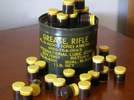Dave DeLaurant
Member
Back to the lubrication part of the OP's question, my advice is to follow the manufacturer's advice regarding oil vs. grease for the specific arm.
As to grease, I still use this stuff according to the FM on my M1 Garand and M1A:

I haven't use grease on much else, firearm-wise.
No expert here, but the thing I am fairly confident in saying is that gun oils can be classed as primarily lubricants, protectants or both (CLP). Most lubricants will protect a bit and vice versa. Penetrating oils like Kroil are another class, strong solvents with lubrication thrown in. The 'C' in CLP means clean, so it also acts as a mild solvent.
Right or wrong, I consider Ballistol as a protectant (and, mixed with water, as a solvent for corrosive primer and black powder residue) and Mobile One as a lubricant. G96 is my CLP of choice, but I probably use more Ballistol than anything else.
FWIW, Ballistol also smells nice -- my cats like it.
As to grease, I still use this stuff according to the FM on my M1 Garand and M1A:

I haven't use grease on much else, firearm-wise.
No expert here, but the thing I am fairly confident in saying is that gun oils can be classed as primarily lubricants, protectants or both (CLP). Most lubricants will protect a bit and vice versa. Penetrating oils like Kroil are another class, strong solvents with lubrication thrown in. The 'C' in CLP means clean, so it also acts as a mild solvent.
Right or wrong, I consider Ballistol as a protectant (and, mixed with water, as a solvent for corrosive primer and black powder residue) and Mobile One as a lubricant. G96 is my CLP of choice, but I probably use more Ballistol than anything else.
FWIW, Ballistol also smells nice -- my cats like it.
Last edited:

